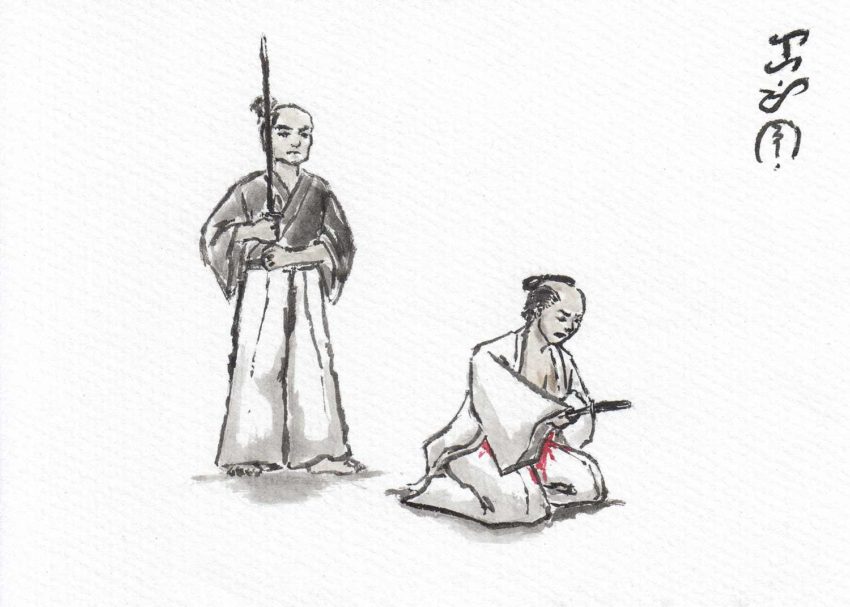In a society as concerned with honor as samurai-era Japan, even the act of suicide had its own qualifiers regarding whether or not the person was acting nobly. Samurai obviously warrant a mention here, if only due to their motto “Death before dishonor.” Read on to find out all about the secretive details about proper ritual suicide. We’ll also contrast that information with how such an act might be deemed dishonorable, and go over the various varieties of Japanese suicide sword used in the act of seppukuSEPPUKU 切腹 "cutting the stomach" learn more....
Seppuku vs. Harakiri
The truth is that the terms seppuku and harakiri are both names for the same act; both translate to something akin to “cutting the abdomen or belly.” This form of suicide involved ritualized disembowelment. It was voluntarily undertaken by a samurai either to avoid losing face against an enemy, as a way to sidestep the risk torture by the enemy faction, or as an act of contrition for bringing shame on himself by behaving shamefully in his master’s name.
As to why there are two words for the same act, it boils down to how the kanji characters are read. “Seppuku” is written 切腹, and is used in Japanese when reading the characters as if they were Chinese. It’s generally the preferred version in text. “Harakiri”, written similarly but with the characters reversed (腹切り) is the term used when reading the word in Japanese; this is used in verbal communication. (As this article is written and not spoken, we’ll stick to using seppuku for ease of clarity.)
As an aside, the regular word for suicide in modern Japanese is jisatsu, likely an evolution of jigai, an older term for general suicide.
The Rules of a Seppuku Sword Suicide Ritual
Traditionally, the ceremony was performed in front of an audience, much in the same manner as public executions in Europe. The poor individual in question would compose a short poem about his life, imbibe two shots of sake, and then do the gory deed, the humble Japanese suicide sword in his hands. Gripping a short-length blade, commonly a tantoTANTO 短刀 "short sword" learn more... or wakizashiWAKIZASHI 脇差 or 脇指 "medium-length sword" learn more..., he would drive it into his stomach and slice across the area from left to right. In cases where the cut was deep enough, an aorta would be severed and ultimately exsanguination became the cause of death. The stomach was chosen as it was believed to house the samurai’s soul; slicing open the stomach allowed the soul to pass on from its dishonorable shell.
Cleaning Up: The Kaishakunin
Because it was a ritual, the individual would appoint a kaishakunin, usually someone very close and trusted, to assist. The kaishakunin’s job was to take another blade and, after the suicide itself, use it to sever the individual’s head. (This would be accomplished with a sword different than the Japanese suicide sword –a longer katana.) The goal was to ensure that the head hung from a piece of flesh so that it could be placed in the samurai’s hands. Failure to make this slice in a single swing, or an accidental full decapitation without the connecting piece of tissue, would in turn bring eternal shame upon the kaishakunin – likely necessitating another seppuku as contrition.
If that’s not hardcore, then nothing is.
Implements of Self-Destruction
There are several nihontoNIHONTO 日本刀 "Japanese sword" learn more... that were commonly used as a Japanese suicide sword, either by the practitioner or elsewhere in the ceremony:
- TantoTANTO 短刀 "short sword" learn more... – This is a short blade, possessing either one or two sharp edges, spanning anywhere from 15 to 26 centimeters in length.
- KaikenKAIKEN 懐剣 "chest dagger" learn more... – This is a short blade very similar to a tanto. Kaiken blades vary anywhere from 20 to 25 centimeters in length and can be single- or double-edged. These were commonly carried by the samurai class as well as their spouses. Spouses?! Yes, it was common practice for the newly-wed wife of a samurai to always carry a kaiken on her person after moving into the samurai’s estate. This obligation also explains why it was common for samurai wives to use it as a suicidal implement. The kaiken may also be called “futokoro-gatana,” meaning “bosom blade,” due to one of the common areas that wives would conceal them. Unlike the other blades on this list, kaiken were bland items lacking ornamentation.
- WakizashiWAKIZASHI 脇差 or 脇指 "medium-length sword" learn more.... This is a blade that can be found anywhere from 30 to 60 centimeters in length. Wakizashis near the bottom of this range, which resemble an exceptionally long tanto, are known as ko-wakizashi and ones that near the top of this range of lengths are known as o-wakizashi; the ko- and o- prefixes translate simply as “small” and “large”. As the katana grew into prominence in the Muromachi Period, this blade replaced the tanto in a samurai’s daishoDAISHO 大小 "big and small" learn more....
- KatanaKATANA 刀 "sword" learn more.... All katana blades are at least 60 centimeters in length. This is the sword that would be used by the kaishakunin to slice the samurai’s neck.
On Seppuku As Corporal Punishment
While the noble practice of a warrior electing to commit ritual suicide is what most people think of when they hear the term seppuku, the truth of the matter is that it was mostly done obligatorily. That is, it was capital punishment for disgraceful actions that, to be fair, even modern people would be imprisoned or sentenced to death for. This form of seppuku involved a full recounting of the samurai’s grossly dishonorable actions, followed by the exact time that they must perform the suicide act. This was often just prior to sunset.
In instances where the individual refused or dragged his feet, officials would usually hold him in place and have an executioner either complete the belly-slicing ritual or simply turn it into an execution by decapitation with only the veneer of ritual. In these situations, the short sword provided to the guilty person to slice his own belly would be exchanged for a fan. Quite a replacement for something as deadly as a Japanese suicide sword.
As you might infer, obligatory seppuku was not a “get out of dishonor free” card. The criminal’s family might also suffer his societal dishonor. Should the criminal’s offenses be severe enough, some or all of his property might be confiscated and his family members could risk loss of rank, personal freedom or (of course) their lives.
Why Would Someone Do This?
The samurai were the first group seen fit to perform seppuku. They were well-paid, well-trained, armored warriors with only one job: to serve their master without question. If anything prevented the samurai from honoring his lord, it was a suitable reason to perform seppuku. A special sub-type of seppuku, read as tsuifuku, involved a samurai taking his life after learning that his master had died. Without a sworn master, especially if the master had no successors to transfer loyalty to, tsuifuku was deemed a perfectly acceptable response for a samurai whom had effectively lost his life’s purpose.
Some samurai enjoyed married life and, just like with most other careers, the wife became somewhat immersed in her husband’s “work culture.” This included performing seppuku upon discovering that her samurai husband had either committed seppuku or behaved dishonorably. Notably, these women would slice their carotid artery in one swift stroke, with a Japanese suicide sword like either a tanto or kaiken. One of the preparatory actions these women would take would be to bind their legs together to avoid leaving their bodies open to violation to enemy factions as a result of the involuntary movement involved in death spasms.
Kanshi was a (relatively) safe way for a samurai to apply the “death before dishonor” maxim to any decision from his master with which he disagreed, without actually killing himself. This practice involved making a non-fatal cut along the belly, then quickly bandaging the wound. The samurai would then speak before his lord, explain his objections, and reveal the bandaged wound.
Jumonjigiri is an extremely brutal alternate form of solitary seppuku. The term means “cross-shaped cut” and centers on employing ones Japanese suicide sword for double duty. Testing the limits of even the most hardened warrior, the act involved making a second, vertical slice along the belly. Jumonjigiri practitioners were to suffer as silently as possible, bleeding out from their gory wounds with their hands placed over the face to hide shame and keep quiet.
Famous Accounts of Seppuku
One reason that seppuku remains in the Japanese consciousness is its presence in famous tales from Japan’s past. In each, the Japanese suicide sword is key to the story. Two of them go like this:
- The Very First Seppuku – The first known instance of ritual seppuku was in 1180 AD. As Minamoto no Yorimasa was losing against the Taira clan in the Battle of Uji, and despite his sons’ willingness to give their lives for their clan, Yorimasa took the honorable way out and became the benchmark example of seppuku.
- Toyotomi Hideyoshi – The legendary warlord was known to have exploited the practice of ordering daimyo to commit seppuku in order to confirm peace agreements. Among the most well-known of these occasions is the ending the Hojo Dynasty. After the Hojo lost the third siege of Odawara in 1590, Hideyoshi demanded that Hojo Ujimasa perform seppuku and that Ujimasa’s son Ujinao be exiled. Ujimasa acquiesced, and when he took his own life in honor of Hideyoshi’s success he also ended the most powerful daimyo clan of eastern Japan.
Japanese Suicide Sword Collecting
The style of swords used for seppuku– short-bladed wakizashi and tango, for example – are frequently sold to collectors. They are still being produced, and while seppuku was a notable way they were used the past, they were really just all-purpose blades for samurai. Owning and displaying a well-crafted short sword from Japan doesn’t necessarily mean you’re referring to suicide, but seppuku remains a haunting aspect of such blades. It’s a significant reason for the compelling sense of honor and ritual that surround any beautiful Japanese sword.

